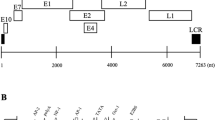Abstract
Bovine papillomaviruses (BPVs) have been described as etiologic agents of cutaneous and mucosal papillomas in cattle. In the present study, we describe a new BPV that was detected in a cutaneous papilloma from a cow. Phylogenetic analysis suggests that this virus belong to the genus Xipapillomavirus, and we refer to it here as BPV type 24 (BPV24). Coinfection with members of the genera Epsilonpapillomavirus and Deltapapillomavirus in a cutaneous papilloma from a different animal was also detected, and the full genomes of these viruses were sequenced. Both papillomas were from cattle within Acre State in the Amazon region of Brazil. The data presented here demonstrate the utility of using high-throughput methods to indentify coinfections and allow the characterization of new genomes.

Similar content being viewed by others
References
Bernard HU, Burk RD, Chen Z et al (2010) Classification of papillomaviruses (PVs) based on 189 PV types and proposal of taxonomic amendments. Virology 401:70–79. https://doi.org/10.1016/j.virol.2010.02.002
de Villiers E-M, Fauquet C, Broker TR et al (2004) Classification of papillomaviruses. Virology 324:17–27. https://doi.org/10.1016/j.virol.2004.03.033
Daudt C, Da Silva FRC, Lunardi M et al (2018) Papillomaviruses in ruminants: an update. Transbound Emerg Dis. https://doi.org/10.1111/tbed.12868
Bauermann FV, Joshi LR, Mohr KA et al (2017) A novel bovine papillomavirus type in the genus Dyokappapapillomavirus. Arch Virol. https://doi.org/10.1007/s00705-017-3443-9
Da Silva FRC, Cibulski SP, Daudt C et al (2016) Novel bovine papillomavirus type discovered by rolling-circle amplification coupled with next-generation sequencing. PLoS One 11:1–11. https://doi.org/10.1371/journal.pone.0162345
Roperto S, Brun R, Paolini F et al (2008) Detection of bovine papillomavirus type 2 in the peripheral blood of cattle with urinary bladder tumours: Possible biological role. J Gen Virol 89:3027–3033. https://doi.org/10.1099/vir.0.2008/004457-0
De Martel C, Ferlay J, Franceschi S et al (2012) Global burden of cancers attributable to infections in 2008: a review and synthetic analysis. Lancet Oncol 13:607–615. https://doi.org/10.1016/S1470-2045(12)70137-7
Goldman B, Rebolj M, Rygaard C et al (2013) Patterns of cervical coinfection with multiple human papilloma virus types in a screening population in Denmark. Vaccine 31:1604–1609. https://doi.org/10.1016/j.vaccine.2012.12.084
Mejlhede N, Pedersen BV, Frisch M, Fomsgaard A (2010) Multiple human papilloma virus types in cervical infections: competition or synergy? Apmis 118:346–352. https://doi.org/10.1111/j.1600-0463.2010.02602.x
Arroyo LS, Smelov V, Bzhalava D et al (2013) Next generation sequencing for human papillomavirus genotyping. J Clin Virol 58:437–442. https://doi.org/10.1016/j.jcv.2013.07.013
PaVE (2018) https://pave.niaid.nih.gov/. Accessed 7 Nov 2018
Daudt C, da Silva FRC, Streck AF et al (2016) How many papillomavirus species can go undetected in papilloma lesions? Sci Rep 6:36480. https://doi.org/10.1038/srep36480
Da Silva FRC, Daudt C, Streck AF et al (2015) Genetic characterization of Amazonian bovine papillomavirus reveals the existence of four new putative types. Virus Genes 51:77–84. https://doi.org/10.1007/s11262-015-1220-y
Daudt C, da Silva FRC, Cibulski SP et al (2016) Complete genome sequence of deltapapillomavirus 4 (Bovine papillomavirus 2) from a bovine papillomavirus lesion in Amazon region, Brazil. Mem Inst Oswaldo Cruz. https://doi.org/10.1590/0074-02760160047
Da Silva FRC, Daudt C, Cibulski SP et al (2017) Genome characterization of a bovine papillomavirus type 5 from cattle in the Amazon region, Brazil. Virus Genes 53:130–133
Edgar RC (2004) MUSCLE: multiple sequence alignment with high accuracy and high throughput. Nucleic Acids Res 32:1792–1797
Bravo IG, Félez-Sánchez M (2015) Papillomaviruses: viral evolution, cancer and evolutionary medicine. Evol Med Public Heal 2015:32–51. https://doi.org/10.1093/emph/eov003
Roperto S, Russo V, Ozkul A et al (2013) Productive infection of bovine papillomavirus type 2 in the urothelial cells of naturally occurring urinary bladder tumors in cattle and water buffaloes. PLoS One 8:e62227. https://doi.org/10.1371/journal.pone.0062227
Munday JS (2014) Bovine and human papillomaviruses: a comparative review. Vet Pathol. https://doi.org/10.1177/0300985814537837
Tomita Y, Literak I, Ogawa T et al (2007) Complete genomes and phylogenetic positions of bovine papillomavirus type 8 and a variant type from a European bison. Virus Genes 35:243–249. https://doi.org/10.1007/s11262-006-0055-y
Acknowledgements
This work was supported by Conselho Nacional de Desenvolvimento Científico e Tecnológico (CNPq), Coordenação de Aperfeiçoamento de Pessoal de Nível Superior (CAPES), Fundação de Amparo à Pesquisa do Rio Grande do Sul (FAPERGS) and Fundação de Amparo à Pesquisa do Estado do Acre (FAPAC). CWC is CNPq productivity research fellow.
Author information
Authors and Affiliations
Corresponding author
Ethics declarations
All lesions were collected by veterinarians for autogenous vaccine preparation, and the project was approved by Universidade Federal do Rio Grande do Sul Ethics Committee (number 28460). This work was carried out in compliance to the European Convention for Protection of Vertebrate Animals Used for Experimental and Other Scientific Purposes as well as the procedures of the Brazilian College of Animal Experimentation (COBEA).
Conflict of interest
All authors declare that they have no conflict of interest.
Additional information
Handling Editor: Zhongjie Shi.
Electronic supplementary material
Below is the link to the electronic supplementary material.
Rights and permissions
About this article
Cite this article
Daudt, C., da Silva, F.R.C., Cibulski, S.P. et al. Bovine papillomavirus 24: a novel member of the genus Xipapillomavirus detected in the Amazon region. Arch Virol 164, 637–641 (2019). https://doi.org/10.1007/s00705-018-4092-3
Received:
Accepted:
Published:
Issue Date:
DOI: https://doi.org/10.1007/s00705-018-4092-3




